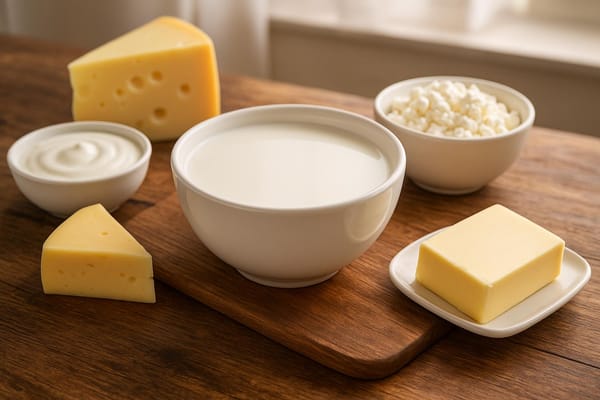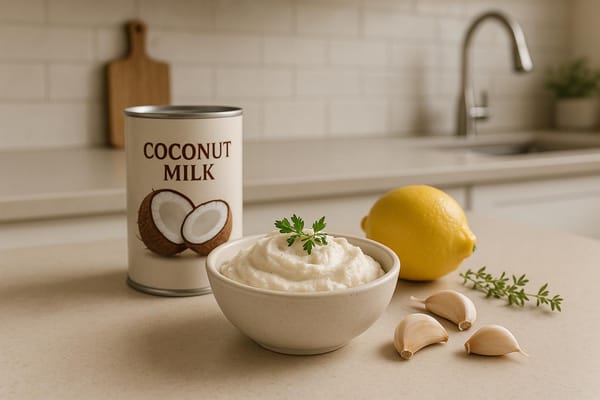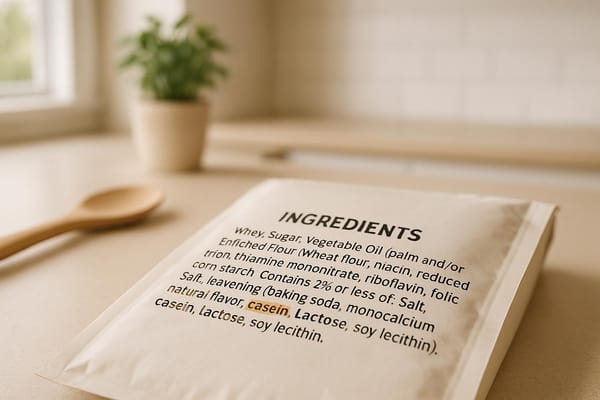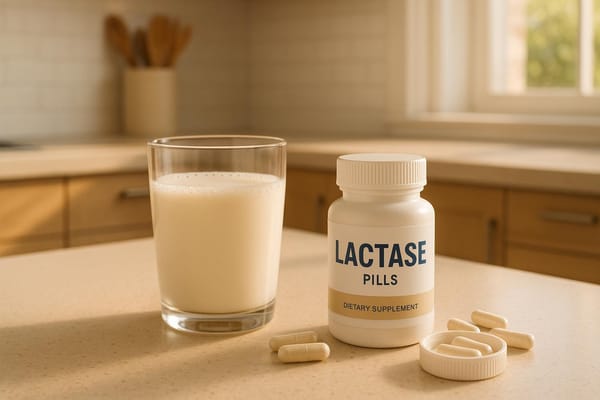17 Hidden Dairy Ingredients to Watch For
Learn to identify 17 hidden dairy ingredients in foods, crucial for those with allergies or lactose intolerance. Stay informed and safe.
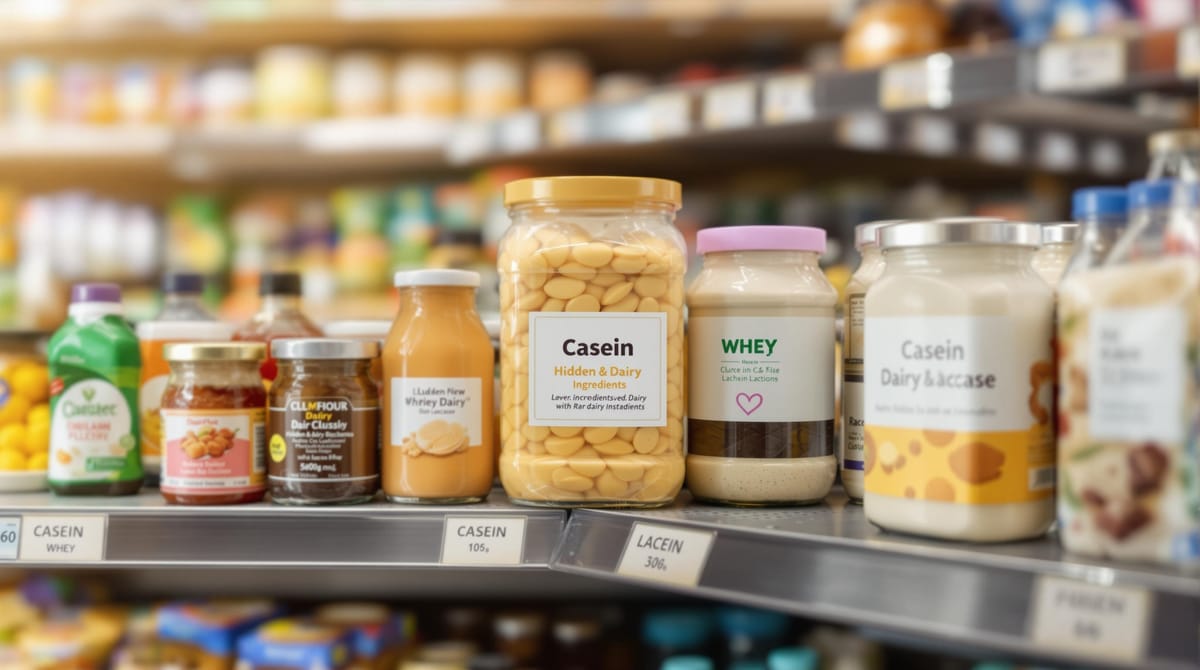
Dairy can hide in unexpected places. Even foods labeled "dairy-free" might contain hidden milk ingredients, posing risks for those with allergies or lactose intolerance. Knowing what to look for on labels is crucial.
Here’s a quick overview of 17 common hidden dairy ingredients:
- Casein: Found in canned tuna, instant potatoes, and deli meats.
- Lactalbumin: Often in protein powders, baked goods, and medications.
- Lactoglobulin: Lurks in processed cheese, snacks, and deli meats.
- Milk Solids: Common in chips, bread, and instant soups.
- Butter Fat: Found in baked goods and sauces.
- Buttermilk: Hides in pancake mixes, dressings, and marinades.
- Cheese: Appears as powders or enzymes in soups and snacks.
- Curds: Used in bread, sauces, and processed foods.
- Custard: Found in desserts, sauces, and pastries.
- Ghee: Used in baked goods and snacks.
- Goat's Milk: Hides in specialty foods and supplements.
- Half & Half: Found in sauces, baked goods, and frozen meals.
- Hydrolysates: Present in protein powders and infant formula.
- Kefir: Added to frozen yogurts and probiotic products.
- Koumiss: Found in international fermented dairy drinks.
- Lactose: Added to snacks, coffee mixes, and medications.
- Whey: Used in protein bars, baked goods, and candies.
Quick Tip: Always check the allergen statement, ingredient list, and certifications like "Parve" or "Pareve" to identify hidden dairy. If you're lactose intolerant, enzyme supplements may help, but those with dairy allergies should avoid these ingredients entirely.
Let’s dive deeper into how these ingredients show up and how to spot them.
What Are Dairy Derivatives?
Dairy derivatives, made from milk, are commonly used in processed foods to enhance texture, flavor, and nutritional content. While some are easy to spot, others show up on labels under less familiar names, making them harder to recognize.
These ingredients play specific roles in food production. For instance, casein is used to bind processed meats, while lactalbumin acts as an emulsifier in dressings. Surprisingly, dairy derivatives can also be found in unexpected products like bread, cereals, certain medications, and even beauty products [1].
Although the FDA mandates that milk-based ingredients must appear on labels, there are gaps in enforcement, especially among small-scale producers. A study by the FDA revealed that even products labeled as "dairy-free" may still contain trace amounts of these ingredients.
"Even 'dairy-free' or 'lactose-free' labels may include trace dairy derivatives, according to FDA findings." [2]
For those dealing with dairy allergies or intolerances, recognizing these ingredients is essential. Look for terms beyond 'milk' or 'cream,' such as lactalbumin phosphate or sodium caseinate. Additionally, kosher labels marked as "Parve" or "Pareve" can offer guidance [1].
Being aware of these derivatives is the first step in spotting hidden dairy ingredients, which we'll dive into further next.
1. Casein
Casein accounts for 80% of the protein in milk and is widely used in processed foods for its binding, emulsifying, and texture-enhancing properties. Surprisingly, it can show up in unexpected products like:
- Canned tuna (as a flavor enhancer)
- Instant potato mixes
- Flavored chips
- Deli meats
- Broths and stocks
Spotting casein on labels can be tricky due to its many alternate names. Here are some common derivatives:
| Casein Derivative | Common Uses | Found In |
|---|---|---|
| Sodium Caseinate | Emulsifier | Processed meats, coffee creamers |
| Calcium Caseinate | Protein fortification | Sports drinks, protein bars |
| Hydrolyzed Casein | Flavor enhancer | Savory snacks, broths |
For those with dairy allergies, casein can cause severe reactions. Meanwhile, individuals with lactose intolerance may experience digestive discomfort if lactose is present. Although the FDA mandates that milk-based ingredients be listed on labels, enforcement isn't always consistent, particularly with niche or small-scale products [2].
When checking labels, look for more than just terms like "milk" or "dairy." Lactose-intolerant individuals may find relief using lactase enzyme supplements to digest casein-containing products. However, people with dairy allergies need to avoid casein entirely, as even tiny amounts can be harmful.
Casein's widespread use and various forms make it a common hidden dairy ingredient. Up next, we'll dive into lactalbumin, another dairy protein often lurking in processed foods.
2. Lactalbumin
Lactalbumin is a whey protein that often sneaks into processed foods, making it tricky for people avoiding dairy. Though it naturally occurs in dairy products like cheese and yogurt, it’s also found in baked goods, protein powders, processed snacks, and even some medications. On ingredient labels, you might see it listed as "milk protein concentrate" or "whey protein isolate."
For those with lactose intolerance, lactalbumin can cause digestive issues. However, for individuals with dairy allergies, it can trigger much more serious immune responses. Enzyme supplements may help lactose-intolerant individuals digest foods containing lactalbumin, but anyone with a dairy allergy should steer clear entirely.
To stay safe, look for products labeled as "dairy-free" or certified as such. When in doubt, contacting the manufacturer directly can provide clarity about hidden ingredients.
Next, we’ll take a closer look at lactoglobulin, another dairy protein with similar concerns.
3. Lactoglobulin
Lactoglobulin is a whey protein commonly used in processed foods as an emulsifier and stabilizer. You'll find it in products like processed cheese, baked goods, protein supplements, and deli meats, often labeled as "whey protein" or "milk protein" [1].
You might also see it listed as:
- Whey protein
- Milk protein
- Dairy protein isolate
- Milk protein concentrate
For some, lactoglobulin can cause digestive problems or allergic reactions, so it's important to read labels carefully [2]. People with lactose intolerance may experience stomach discomfort, while those with dairy allergies could face serious reactions, including anaphylaxis [2][3].
When shopping, don’t rely solely on front-label claims. Check the full ingredient list for hidden dairy proteins. Certifications like Parve or Pareve can indicate a product is dairy-free, but it’s still smart to double-check [1]. If you're unsure about a product, reach out to the manufacturer for clarification.
For those with lactose intolerance, enzyme supplements might help when eating foods that could contain lactoglobulin. However, anyone with a dairy allergy should avoid this protein completely and consult a healthcare provider for advice [2][3].
Next, we’ll take a closer look at milk solids, another often-overlooked dairy ingredient.
4. Milk Solids
Milk solids, often labeled as milk powder, skim milk solids, or similar terms, are a hidden source of dairy in many processed foods. You might see them listed as:
- Milk powder
- Dried milk
- Evaporated milk
- Milk protein concentrate
- Skim milk solids
These ingredients sneak into unexpected products like instant potatoes, canned tuna, chips, and bread [1]. For example, milk solids can enhance the flavor of chips or act as stabilizers in canned tuna [2].
Containing both lactose and dairy proteins, milk solids can be problematic for those with dietary restrictions. They're often added to improve soup textures, bind processed meats, condition bread dough, and boost the flavor of snacks.
To ensure you're avoiding dairy, look for kosher certifications such as "Parve" or "Pareve", which generally indicate a product is dairy-free [2]. However, always double-check the ingredient list, as certification standards may differ.
If you have a dairy allergy, it's best to avoid these ingredients entirely and consult a healthcare professional for advice [3].
Milk solids are just one way dairy can hide in processed foods. Up next: butter fat, another ingredient to watch for.
5. Butter Fat
Butter fat, also known as milkfat, is a natural component of dairy and is frequently added to processed foods to improve flavor and texture. It can be listed on ingredient labels under names like:
- Concentrated milk fat
- Butter oil
- Milk/dairy fat solids
You’ll often find butter fat in commercial baked goods, processed meats, and sauces. Many premium ice cream brands use it to achieve a richer, creamier texture.
This ingredient contains both lactose and milk proteins, which can be problematic for people with lactose intolerance or dairy allergies. Kosher symbols like "D" or "DE" on food labels often indicate the presence of dairy, including butter fat [1]. To steer clear of it, look for products labeled as "dairy-free" or "pareve."
If you're lactose intolerant but occasionally consume dairy, enzyme supplements can assist with digestion. However, for anyone with a dairy allergy, butter fat should be completely avoided.
Another dairy ingredient to watch for is buttermilk, which can also contain lactose and dairy proteins.
6. Buttermilk
Buttermilk is a dairy product often found in processed foods, sometimes in ways you might not expect. It contains both lactose and dairy proteins, which can be problematic for people with lactose intolerance or dairy allergies.
| Label Term | Description |
|---|---|
| Buttermilk Powder | A dehydrated form used in dry mixes |
| Buttermilk Solids | Concentrated dairy components |
| Cultured Buttermilk | A fermented liquid version |
| Dried Buttermilk | Another name for powdered buttermilk |
You’ll often find buttermilk in commercial baked goods like pancake and waffle mixes, salad dressings, biscuits, cakes, and even some types of bread. It’s typically added to improve moisture and texture.
Keep an eye out for buttermilk in:
- Packaged baked goods
- Pre-made dressing mixes
- Instant soup bases
- Marinades and sauce blends
- Frozen breakfast options
For those with lactose intolerance, lactase supplements can help digest buttermilk. However, if you have a dairy allergy, you should avoid it entirely, as the milk proteins can still cause reactions even with supplements.
Next, we’ll dive into cheese, another dairy ingredient that’s often hidden in processed foods.
7. Cheese
Cheese shows up in processed foods more often than you'd think - and not always in obvious ways. As a dairy product, it can appear under names that are tricky to spot, making label reading a must.
| Hidden Cheese Forms | Where You'll Find Them |
|---|---|
| Cheese Cultures | Canned soups, sauces |
| Cheese Enzymes | Processed meats, dressings |
| Cheese Powder | Seasoned snacks, instant meals |
Many food products contain cheese-based ingredients without clearly stating it on the front label. For example, some canned tuna brands use cheese-derived additives for flavoring [2]. Even bread might have traces of cheese due to shared production equipment [1].
How to Spot Cheese on Labels:
- Look for terms like casein, whey, or natural flavors - these might signal cheese derivatives.
- Kosher labels like Parve or Pareve can guide you toward dairy-free options [1].
- Be cautious with vague terms like "natural flavors", as they may include cheese-based ingredients.
If you're lactose intolerant and accidentally eat something with hidden cheese, enzyme supplements can help ease symptoms. However, for those with dairy allergies, even small traces of cheese proteins can cause serious reactions, so vigilance is key.
Products to Watch Out For:
- Processed snacks
- Canned soups
- Frozen meals
- Salad dressings
Cheese isn't always listed as a direct ingredient - it can sneak in through cross-contamination during manufacturing. If you're highly sensitive, opting for products with clear dairy-free certifications is the safest bet.
Cheese is just one of the many ways dairy can hide in processed foods. Up next, we'll dive into curds, another overlooked dairy ingredient.
8. Curds
Curds, often linked to cottage cheese, are a lesser-known dairy ingredient used as a thickener and binding agent in many processed foods. While most people associate curds with cottage cheese, they can show up in unexpected products under different names.
Since curds contain both lactose and milk proteins, they can cause issues for those with dairy sensitivities. You might find them in:
- Commercial bread products
- Pre-made sauces
- Processed foods as thickeners
- Certain flavor enhancers made from dairy
When reading labels, look for terms like "milk solids", "casein," or "dairy protein" [1]. To avoid hidden curds, opt for products labeled "Parve" or "Pareve", as these are certified dairy-free [2].
If you’re lactose intolerant and accidentally consume curd-containing products, enzyme supplements may help ease symptoms. However, for those with dairy allergies, even trace amounts can cause severe reactions, so it’s essential to be extra cautious.
Cross-contamination during manufacturing is another concern. Even products labeled as dairy-free might contain traces of curds. When unsure, reaching out to manufacturers directly can help clarify if their products are truly free from dairy [2].
Next, we’ll dive into custard, another dairy-based ingredient that often hides in processed foods under various names.
9. Custard
Custard is a creamy blend of milk, sugar, and eggs that often sneaks into processed foods under different names. It's a common ingredient in both sweet and savory dishes, making it tricky to steer clear of. While it's easy to spot in desserts like crème brûlée or flan, custard and its variations also show up in ice creams, pastries, puddings, sauces, and quiches.
On food labels, custard might go by these names:
| Common Label Terms | Hidden Names |
|---|---|
| Custard powder | Milk solids |
| Crème anglaise | Butterfat |
| Pastry cream | Dairy protein |
For those with lactose intolerance, even small traces of custard can cause discomfort due to its high lactose and dairy protein content. Enzyme supplements might help manage symptoms, but people with dairy allergies should completely avoid it.
To steer clear of hidden custard, look for products labeled "dairy-free" or try making your own desserts using non-dairy substitutes. Up next, we’ll dive into ghee, another dairy ingredient that often hides under unfamiliar names in processed foods.
10. Ghee
Ghee, a type of clarified butter widely used in Indian and Middle Eastern cooking, often sneaks into processed foods. While it adds a rich taste and has a high smoke point, it can still be problematic for people with dairy sensitivities.
You might find ghee in baked goods, sauces, packaged snacks, or ready-to-eat meals. On ingredient lists, it could be listed as clarified butter, butter oil, anhydrous milk fat, or butterfat concentrate.
Even though ghee has less lactose than typical dairy products, it’s still a dairy-based ingredient that may cause issues for sensitive individuals. Smaller producers might not always follow FDA labeling guidelines, so it’s important to check labels carefully.
For those with lactose intolerance, milktab's triple-enzyme formula - a mix of lactase, protease, and lipase - can help break down ghee in foods. However, anyone with a dairy allergy should steer clear of ghee entirely.
Next, let’s look at goat’s milk, another dairy product that might show up in unexpected ways.
11. Goat's Milk
Goat's milk is often viewed as easier to digest than cow's milk. However, it still contains lactose and proteins like casein and whey, which can cause issues for some people. Beyond the usual suspects like cheese and yogurt, goat's milk can also sneak into less obvious products such as artisanal breads, specialty ice creams, and even nutritional supplements.
Manufacturers sometimes use terms like "caprine milk", "goat milk powder", or "goat whey" on labels, making it harder to identify as dairy. Even products marked as "lactose-free" might include derivatives of goat's milk, so carefully reading labels is crucial.
| Common Names for Goat's Milk on Labels |
|---|
| Caprine milk |
| Goat milk powder |
| Goat whey |
| Goat milk solids |
| Caprine dairy derivatives |
If you're lactose intolerant, products like milktab's triple-enzyme formula might help you digest goat's milk. However, if you have a dairy allergy, it's best to avoid goat's milk entirely. Cross-contamination is also a concern, especially in facilities handling multiple dairy products.
Goat's milk isn't the only hidden source of dairy - other derivatives can show up in unexpected ways, as we'll explore next.
12. Half & Half
Half & half is a dairy product made from equal parts milk and cream, with a fat content of 10% to 12%. It's widely used but often shows up in processed foods like baked goods, sauces, and frozen meals - posing a challenge for people with dairy sensitivities.
You might see half & half listed on ingredient labels as:
- Milk and cream
- Light cream
- Dairy creamer
- Natural flavors
For those with lactose intolerance, half & half can cause digestive discomfort due to its lactose content. People with dairy allergies face even higher risks, as it contains dairy proteins that can trigger severe allergic reactions [2].
The FDA requires food labels to clearly state the presence of milk and its derivatives, including half & half. However, some small-scale producers may not always comply with these rules, so it's wise to be extra cautious when consuming artisanal or locally made products [2].
Lactose-intolerant individuals can consider supplements like milktab to help process the lactose in half & half. However, anyone with a dairy allergy should steer clear of it altogether.
While half & half is a familiar ingredient, less obvious dairy-derived products like hydrolysates also deserve attention.
13. Hydrolysates
Hydrolysates are milk proteins, such as casein or whey, that have been broken down into smaller pieces. On food labels, they often appear as terms like hydrolyzed casein, whey protein hydrolysate, or simply "protein hydrolysate."
You’ll typically find hydrolysates in products like:
| Product Category | Examples |
|---|---|
| Sports Nutrition | Protein powders, energy bars, recovery drinks |
| Infant Products | Baby formula, cereals, nutritional supplements |
| Processed Foods | Instant potatoes, canned tuna, flavored chips |
| Baked Goods | Bread, pastries, crackers |
For people with dairy sensitivities, hydrolysates can still be a problem. Those with lactose intolerance may react to leftover lactose, while individuals with dairy allergies could experience immune responses to the protein fragments.
Dairy-free options do exist. Plant-based hydrolysates, made from ingredients like pea or soy, are a suitable alternative. If you’re lactose intolerant, enzyme supplements can help you digest dairy-based hydrolysates. However, if you have a dairy allergy, it’s safest to avoid them altogether.
Although hydrolysates are often hidden in processed foods, it’s worth noting that fermented dairy products like kefir bring their own unique challenges.
14. Kefir
Kefir is a fermented milk product often added to processed foods for its probiotic benefits. Even though it's fermented, it remains a dairy ingredient, which can pose issues for those with lactose intolerance or dairy allergies.
On ingredient lists, kefir might be listed under different names, such as:
| Label Term | Found In |
|---|---|
| Milk Culture | Yogurt alternatives |
| Fermented Milk | Protein bars |
| Probiotic Culture | Nutritional supplements |
| Cultured Dairy Blend | Frozen desserts |
The fermentation process reduces lactose but leaves behind dairy proteins, which can still trigger allergic reactions. It's commonly found in frozen yogurts and other products marketed as probiotic-enriched.
If you're lactose intolerant, enzyme supplements might help you digest foods containing kefir. However, if you have a dairy allergy, it's best to avoid kefir entirely due to its milk protein content.
Watch for terms like "probiotic-rich" or "cultured" on labels, as they often indicate the presence of kefir. For non-dairy alternatives, consider options like:
| Alternative | Made From |
|---|---|
| Coconut Kefir | Coconut water or milk |
| Soy Culture | Fermented soy milk |
| Plant-Based Options | Water, rice, or other plant bases |
These choices offer probiotic benefits without the risks associated with dairy. While kefir might seem like an uncommon ingredient, its growing presence in everyday products makes it essential to check labels carefully - especially when considering other hidden dairy sources like koumiss.
15. Koumiss
Koumiss is a fermented milk drink that originates from Central Asia. While it's not commonly found in Western diets, it's starting to appear in international and specialty food products.
This drink contains both lactose and dairy proteins, which can be problematic for people with dairy allergies or sensitivities. Although fermentation reduces some of the lactose, the remaining dairy proteins can still trigger allergic reactions.
You might see koumiss labeled as 'fermented milk product,' 'mare's milk culture,' or 'cultured dairy ingredient' in items like specialty yogurts, ethnic drinks, or probiotic supplements.
Where You Might Find It:
- Foods and beverages from Eastern Europe or Central Asia
- Fermented dairy drinks
- Probiotic-focused products
- International specialty foods
Important Notes: If you have a dairy allergy, it's best to avoid koumiss altogether because of its protein content. For those with lactose intolerance, it might be tolerable with the help of lactase enzymes, but proceed cautiously.
Not sure if a product contains koumiss? Reach out to the manufacturer. Many companies provide detailed allergen information when asked.
As international cuisines become more popular, it's important to recognize ingredients like koumiss on labels. Being aware of these terms can help you avoid hidden dairy, a topic we'll dive into more in the next section.
16. Lactose
Lactose is the main sugar found in milk and dairy products. Beyond its natural presence, it's often added to processed foods to sweeten or improve texture. What’s surprising is how frequently it shows up in unexpected items.
Decoding Lactose on Food Labels:
| Term | Meaning |
|---|---|
| Milk Sugar | Pure Lactose |
| Natural Flavors | Could Include Lactose |
| Modified Milk Ingredients | Contains Lactose |
| Dairy Product Solids | Contains Lactose |
| Lactose Monohydrate | Pure Lactose |
| Whey Sugar | Lactose from Whey |
You might encounter lactose in:
- Instant coffee mixes
- Medications and supplements
- Flavored chips
- Instant potato products
Even some products marketed as non-dairy may include lactose for texture or flavor. Items labeled as "creamy", "buttery", or "milk-flavored" are common culprits.
For those with lactose intolerance, lactase supplements can help break down hidden lactose in foods. Still, the safest bet is to look for "dairy-free" or "lactose-free" certifications instead of relying solely on ingredient lists [1][2].
While lactose is a milk-derived sugar, whey - a related dairy ingredient - has a different purpose in processed foods. More on that next.
17. Whey
Whey is a liquid byproduct of cheese-making and one of the most widely used dairy ingredients in processed foods. While it's often associated with protein supplements, its uses go far beyond sports nutrition.
Common Forms of Whey in Food Labels:
| Form | Typical Uses | Found In |
|---|---|---|
| Whey Protein Concentrate | Boosting protein content | Energy bars, sports drinks |
| Delactosed Whey | Nutritional additive | Processed meats, baked goods |
| Demineralized Whey | Binding agent | Infant formula, candy |
For those with dairy sensitivities, whey can be tricky. It contains both lactose and milk proteins, making it problematic for people with lactose intolerance or dairy allergies. Whey often hides in unexpected products like commercial breads, processed meats, and flavored snacks [1][2].
Pay close attention to labels, especially on items marketed as "creamy" or "protein-enriched." If you're lactose intolerant and accidentally consume whey, lactase enzyme supplements might ease symptoms. However, anyone with a dairy allergy should steer clear of whey altogether [2][3].
Recognizing the various forms of whey can help you spot hidden dairy ingredients, an essential step for managing dietary restrictions.
How to Avoid Hidden Dairy Ingredients
Spotting hidden dairy in food products can be tricky, but a careful approach to reading labels can help. Start by checking the allergen statement, usually located below the ingredient list. According to FDA rules, this section must clearly list any milk ingredients [2].
Key Steps for Reading Labels
When scanning labels, follow these steps:
- Look at the allergen statement first.
- Go through the ingredient list carefully.
- Check for certification symbols.
- Keep a list of products you know are safe.
Be extra cautious with certain food categories like deli meats, soups, snacks, and ready-made meals. Surprisingly, dairy can also show up in non-food items like personal care products and medications [2].
Decoding Certifications
Kosher labels such as "Parve" or "Pareve" often indicate a product is dairy-free. However, symbols like "D" or "DE" mean the product either contains dairy or was processed on equipment that handles dairy. Always double-check the ingredient list, even if a certification is present [1].
Preventing Cross-Contamination
Cross-contamination can occur during manufacturing or at food service counters. When buying from deli counters or similar setups, ask staff to use clean equipment and fresh gloves to reduce the chance of dairy exposure [2][3].
If you're managing lactose intolerance rather than a dairy allergy, enzyme supplements may help when avoiding dairy completely isn't possible. However, for those with dairy allergies, strict avoidance is essential. Carry emergency medication and any necessary medical documentation at all times [2].
A Note on "Non-Dairy" Labels
The term "non-dairy" can be misleading, as it isn't always strictly regulated. To be safe, choose products from brands that cater specifically to dairy-free consumers and provide clear ingredient labeling. Always recheck products, as their formulations can change over time [1][2].
Staying vigilant about hidden dairy is important, but learning how to manage your diet effectively can make things easier.
Lactose Intolerance Solutions
For people with lactose intolerance, enzyme supplements can make it easier to enjoy dairy products by providing the lactase enzyme their body lacks. This enzyme helps break down lactose, making it easier to digest hidden dairy in foods.
Products like milktab offer a triple-enzyme formula that targets lactose, protein, and fat digestion. This kind of formulation is particularly helpful for breaking down hidden dairy in processed foods, reducing the risk of digestive discomfort [1].
When selecting enzyme supplements, prioritize options that are third-party tested, vegan, and free from common allergens to ensure safety and effectiveness. These supplements should be taken right before eating foods that could contain hidden dairy.
Here are some key points to keep in mind:
- These supplements are designed for lactose intolerance, not dairy allergies [1].
- Start with small amounts of dairy to see how your body reacts.
- Reading food labels is still important, even when using supplements.
- Individual responses to enzyme supplements can vary.
Enzyme supplements can be a helpful tool for managing lactose intolerance, especially when hidden dairy is accidentally consumed. However, they work best alongside efforts to identify and avoid dairy ingredients [2]. For those with dairy allergies, strict avoidance of all dairy products is still necessary, as supplements won't prevent allergic reactions [1][2].
While these supplements offer support, avoiding hidden dairy remains the most reliable approach for those with severe sensitivities.
Conclusion
Hidden dairy in processed foods can be tricky to spot, making it essential to stay alert and informed. While the FDA requires clear labeling, gaps in enforcement mean you need to recognize alternative names for dairy ingredients. Reading labels carefully is a must for managing health and dietary needs.
Dairy can show up in unexpected places, so knowing what to look for is key. For those with lactose intolerance, enzyme supplements may help expand dietary options. However, these aren't an option for individuals with dairy allergies, who need to avoid all dairy products entirely [1].
As the food industry adapts to dietary restrictions, labeling is improving, and more dairy-free options are becoming available. Steps like choosing certified dairy-free products, cooking from scratch, and reaching out to manufacturers for clarification can make managing your diet easier [2].
Avoiding dairy while maintaining a balanced diet is entirely possible. Whether you're dealing with lactose intolerance or a dairy allergy, understanding hidden dairy ingredients gives you the tools to make smarter food choices that support your health [1][2].
Success comes from staying informed and using practical strategies. With the right approach, you can confidently handle dietary challenges and steer clear of hidden dairy ingredients.
FAQs
Which ingredient is a common source of hidden dairy?
Breadcrumbs and croutons often sneak in dairy, which can be tricky for anyone avoiding milk products. Options like Panko breadcrumbs or cornflake crumbs are usually dairy-free, but always double-check the label to be sure [1].
Dairy can also hide in surprising places, such as canned tuna, instant potatoes, and flavored chips. These examples show how easy it is to overlook less obvious sources of dairy in everyday items [2].
If you're lactose intolerant, enzyme supplements might help you digest hidden dairy. However, for those with dairy allergies, even trace amounts must be strictly avoided [1][2].
Certifications like "Parve" or "Pareve" can guide you toward dairy-free options. Be cautious with symbols like "D" or "DE", as they indicate the presence of dairy or shared manufacturing equipment [1].
Since product recipes can change without notice, it’s a good idea to check ingredients regularly - even on items you’ve bought before. When unsure, reach out to the manufacturer to confirm if a product contains dairy [2].
Being proactive about spotting hidden dairy helps you stick to your dietary needs with confidence.
